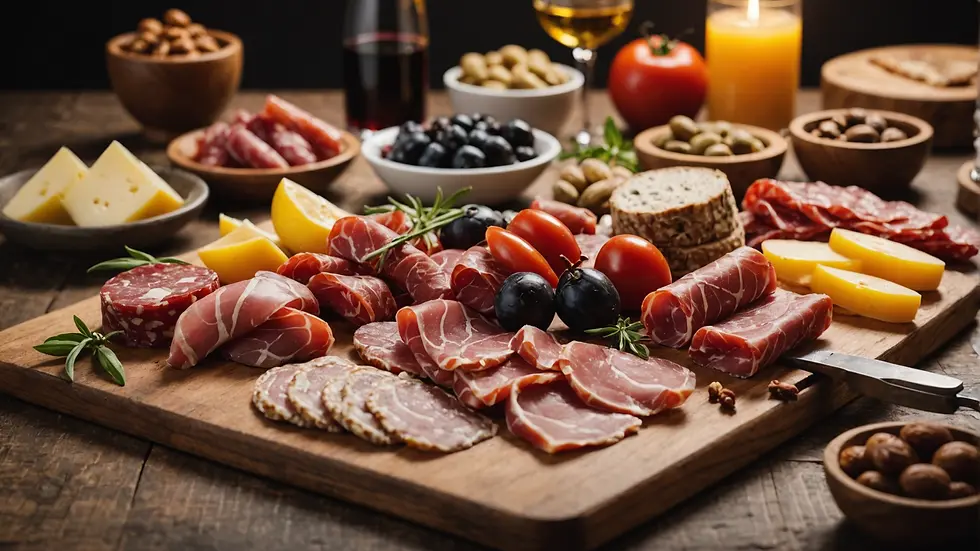Italian Charcuterie: The Ultimate Guide to Crafting a Masterful Artisanal Board
- Oct 31, 2024
- 4 min read
Italian charcuterie boards, known as “spuntini,” showcase the rich flavors of Italy through a carefully chosen mix of cured meats, cheeses, olives, and seasonal fruits. Crafting these boards is not just about food; it's an artistic expression of color, texture, and taste that reflects the season and the occasion. This guide will unveil the secrets to creating the perfect Italian charcuterie board, whether for a cozy gathering or a grand celebration.
The Origins of Italian Charcuterie
Charcuterie has deep roots in Italy, where the art of preserving meats evolved over centuries. Each region boasts its own traditions, emphasizing local ingredients and time-honored methods. Cured meats like prosciutto, salami, and bresaola have become cornerstones of Italian cuisine, often painstakingly crafted through processes that enhance their flavors.
For example, prosciutto is typically aged for 12-36 months, developing a delicate sweetness. Salami can range from spicy varieties, like 'nduja, to milder ones, giving options for diverse palates. Understanding these traditions can deepen your appreciation of the culinary artistry behind a charcuterie board.

Essential Components of an Italian Charcuterie Board
The heart of an exceptional Italian charcuterie board lies in its components. Each selection contributes to a delightful tasting experience.
1. Cured Meats
Choose various cured meats with different textures and flavors. For your board, consider:
Prosciutto: Aged for at least a year, it delivers a sweet flavor and pairs perfectly with melon.
Salami: Types like Milano bring a smooth, mildly spiced taste, while spicy varieties can provide a kick.
Bresaola: This air-dried, aged beef has a rich flavor and pairs well with arugula and olive oil.
Experimenting with regional options can elevate the overall presentation.
2. Cheeses
Italian cheeses are crucial for complementing meats and enhancing taste variety. Here are some standout choices:
Parmesan: This nutty cheese is best served with dried fruits like apricots or figs and can enhance the richness of meats.
Gorgonzola: A blue cheese that offers a sharp contrast, pairing wonderfully with honey or balsamic glaze.
Pecorino Romano: Its salty zest harmonizes beautifully with sweeter fruits, like pears, creating a balanced bite.
Combining different cheese textures adds depth to your board.
3. Accompaniments
To round out your charcuterie board, consider:
Olives: A mix of green and black olives enhances the overall flavor, while marinated varieties add a zesty touch.
Fruits: Including seasonal options like figs or strawberries for sweetness and brightness is a must.
Accompaniments elevate flavors and create a holistic tasting experience.
The Aesthetic Appeal: Arranging Your Board
Once your ingredients are ready, it's time to create a visually stunning arrangement.
1. Choosing the Right Board
A wooden or slate board serves as an ideal canvas. Choose one that fits your guest count—larger boards offer space for elaborate designs, while smaller ones set a cozy vibe.
2. Layering and Balance
Start with larger items, like cheeses, arranging them in triangles across the board. Next, cluster cured meats around the cheeses. This arrangement not only creates visual interest but also keeps the flavors harmonious.
3. Consider Height and Volume
For added visual appeal, mix heights within the arrangement. Use small bowls for nuts or spreads, and elevate certain cheese wedges. This creates dimension and encourages interaction.
Enhancing the Flavor Experience
Creating a memorable tasting journey involves thoughtfully pairing flavors.
1. Pairing Ingredients
Strategic pairings can enhance flavors. For example, pairing prosciutto with sweet melon cleverly balances savory and sweet. Consider creamy cheeses accompanied by toasted bread for a delightful crunch.
2. Incorporating Seasonal Ingredients
Flexibility is key. Use seasonal ingredients to ensure freshness. In spring, add asparagus and radishes; in the fall, roasted chestnuts or apples can bring warmth. This approach not only respects the ingredients but also enriches the board's appeal.
3. Flavor Depth with Spices and Herbs
Fresh herbs like basil or rosemary can amplify flavors. Lightly sprinkle them over cheese or meats to introduce aromatic notes.
4. Adding Gourmet Crackers
Offering a selection of gourmet crackers, especially those infused with herbs, can add subtle flavor and texture contrasts to your charcuterie experience.
Beverage Pairings to Enhance Your Board
The perfect beverage match can elevate the entire tasting experience.
1. Wine Selection
Italian wines are the quintessential pairing. Here are some to consider:
Chianti: Its bright acidity complements cured meats, enhancing their flavors.
Prosecco: This sparkling wine refreshes the palate and contrasts rich cheeses nicely.
Barbera: Known for its light tannins, it pairs well with varied flavors on the board.
2. Non-Alcoholic Options
Sparkling water with lemon or fresh herbs makes for a refreshing non-alcoholic choice. It cleanses the palate and complements complex flavors.
3. Creative Cocktails
Simple cocktails made with Italian spirits, like Aperol or Campari, provide a fun twist. An Aperol Spritz is particularly refreshing and complements the rich tastes of the board.
Final Touches Before Serving
Before serving, consider these finishing touches:
1. Garnishing
A sprinkle of fresh herbs or edible flowers can enhance your board's beauty while contributing enticing aromas.
2. Serving Utensils
Offering small forks, toothpicks, and spreaders helps guests sample without feeling overwhelmed. It encourages a casual and inviting atmosphere.
3. Inviting Guests to Indulge
Encourage guests to explore flavors in their own way, trying different combinations of meats, cheeses, and accompaniments. This interactive experience fosters conversation and enjoyment.
The Last Word on Charcuterie
Creating an Italian charcuterie board combines artistry, tradition, and personal expression. The goal is to balance flavors, textures, and presentation, making each board a unique reflection of your creativity and the occasion.
By understanding ingredient origins, selecting quality items, and arranging them thoughtfully, you will craft a charcuterie board that delights the palate and fosters connection among diners.
Sharing good food is a celebration of community. Whether you are hosting a gathering or a quiet night in, remember that your Italian charcuterie board is a canvas of culture, warmth, and artistry. Enjoy every bite as you embark on your culinary adventure through Italy’s rich flavors.










Comentários